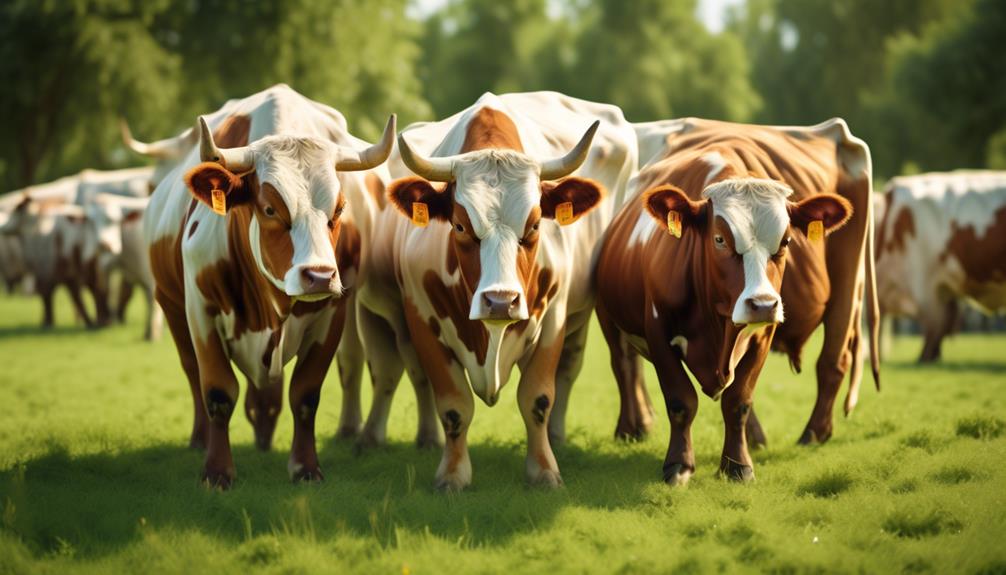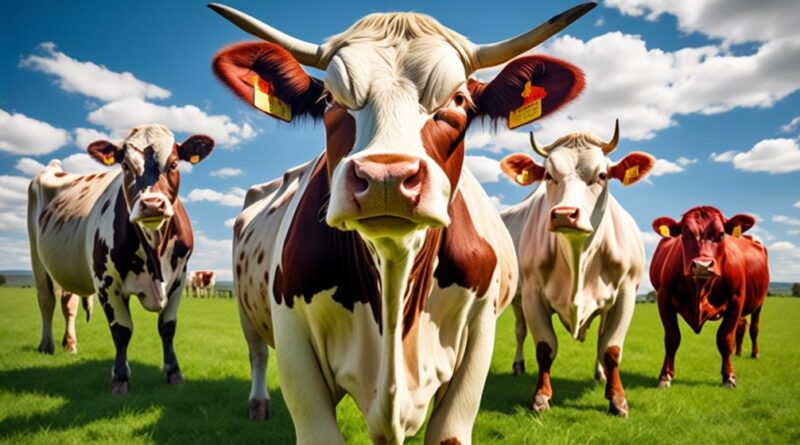3 Best Disease-Resistant Cattle Breeds for Sustainable Farming
When it comes to sustainable farming, finding cattle breeds that are disease-resistant is like uncovering a hidden treasure in the world of agriculture. You want to ensure the health and well-being of your herd without constantly battling illnesses that can wreak havoc on your farm.
But which breeds are the best suited to withstand common diseases while thriving in sustainable farming practices? The answer lies in a careful selection of cattle breeds that possess natural resilience, and in this discussion, we'll explore three of the best disease-resistant cattle breeds that could be the key to your farm's success.
Angus
When raising disease-resistant cattle, consider the Angus breed for its adaptability and hardiness in various farming conditions. Angus cattle are known for their resilience and resistance to common diseases, making them a top choice for sustainable farming. The breeding techniques for Angus cattle are designed to enhance their disease resistance. Through selective breeding, farmers can develop a herd with strong immune systems, reducing the risk of disease outbreaks and minimizing the need for antibiotics or other medical interventions. This not only benefits the cattle but also contributes to sustainable and ethical farming practices.
In addition to their disease resistance, Angus cattle are also in high market demand. Their reputation for producing high-quality meat has made them a favorite among consumers and in the beef industry. This market demand creates an incentive for farmers to prioritize breeding and raising Angus cattle, ensuring a steady and profitable market for their livestock.
Brahman
If you're considering expanding your disease-resistant cattle breeds, the Brahman breed offers remarkable adaptability and resilience in diverse farming environments. Brahman cattle are renowned for their exceptional heat tolerance, making them well-suited for hot and humid climates. Their ability to withstand high temperatures and thrive in harsh conditions makes them a valuable asset for sustainable farming practices in various regions.
Additionally, Brahman cattle exhibit outstanding adaptability to different environments, allowing them to thrive in a wide range of geographical locations. Whether it's the arid heat of the southern regions or the more temperate climates of the northern areas, Brahman cattle have shown an impressive capacity to adapt and flourish.
The heat tolerance of Brahman cattle stems from their unique genetic makeup, which includes a distinct hump over the shoulders and loose, thick skin that aids in heat dissipation. These physical characteristics enable them to regulate their body temperature efficiently, allowing them to endure high temperatures without succumbing to heat stress. Furthermore, their adaptability to different environments is attributed to their ability to efficiently utilize sparse vegetation and endure challenging environmental conditions.
Red Angus
Red Angus cattle breed is known for its excellent marbling and meat quality, making it a popular choice among cattle producers. This breed offers several genetic traits that make it a valuable asset in breeding programs. Red Angus are known for their adaptability to various climates and their ability to thrive in different grazing management systems.
Red Angus: Genetic Traits, Breeding Programs
- Excellent Marbling: Red Angus are renowned for their ability to produce well-marbled beef, which is highly desirable among consumers. This genetic trait contributes to the breed's popularity in breeding programs aimed at improving meat quality.
- Maternal Characteristics: Red Angus cows are known for their strong maternal instincts, ease of calving, and good milk production. These traits make them an ideal choice for breeding programs focused on enhancing the productivity of the herd.
- Genetic Purity: Red Angus breeders place a strong emphasis on maintaining genetic purity within the breed. This dedication to genetic integrity makes Red Angus a reliable choice for breeding programs seeking to preserve and improve specific genetic traits.
Red Angus cattle have demonstrated remarkable adaptability to various climates, making them a versatile choice for sustainable farming. Their ability to thrive in different grazing management systems further enhances their appeal to cattle producers seeking resilient and low-maintenance breeds.
Shorthorn
Shorthorn cattle, known for their versatile utility and historical significance, are a breed highly valued for their adaptability and genetic diversity in sustainable farming practices.
Shorthorn cattle breed characteristics include their medium to large build, with cows weighing around 1,400 pounds and bulls reaching up to 2,000 pounds. They're renowned for their docile temperament, making them easier to handle, and their ability to thrive in various climates, from hot and arid regions to cooler, more temperate areas. Additionally, Shorthorns are prized for their efficient conversion of forage into high-quality beef, making them an economically attractive choice for sustainable farming.
When it comes to Shorthorn cattle breeding techniques, there's a focus on preserving the breed's genetic diversity and adaptability. Breeders often utilize performance testing and genetic selection to maintain and improve desirable traits within the population. This includes assessing factors such as feed efficiency, maternal characteristics, and disease resistance.
Furthermore, careful mating selection is employed to ensure that the offspring exhibit the preferred traits of the Shorthorn breed while minimizing the risk of hereditary health issues.
Tuli
Tuli cattle, known for their exceptional heat tolerance and resistance to common cattle diseases, are a valuable breed for sustainable farming practices. If you're considering incorporating Tuli cattle into your farm, it's important to understand the breeding techniques and disease resistance strategies that make them such a robust breed.
Here are some key points to consider:
- Tuli cattle breeding techniques
- Tuli cattle are well-adapted to harsh environments, making them an excellent choice for sustainable farming in hotter climates.
- When breeding Tuli cattle, it's important to prioritize their natural heat tolerance and disease resistance traits.
- Selective breeding can further enhance these desirable characteristics, ensuring that future generations maintain the breed's resilience.
- Tuli cattle disease resistance strategies
- One of the reasons Tuli cattle are highly sought after is their natural resistance to common cattle diseases.
- Implementing proactive disease prevention measures, such as regular veterinary check-ups and maintaining a clean and hygienic environment, can further support their innate disease resistance.
- Additionally, providing Tuli cattle with a balanced diet and access to clean water strengthens their immune systems, contributing to their overall health and resilience against diseases.
Senepol
When considering sustainable farming practices, incorporating the disease-resistant and heat-tolerant Senepol cattle breed can greatly benefit your farm. Senepol cattle are renowned for their adaptability to different climates, making them an excellent choice for farmers in various regions. Whether you're operating in hot and humid environments or more temperate climates, Senepol cattle can thrive and contribute to the sustainability of your farm.
One of the key advantages of Senepol cattle is their remarkable resistance to common cattle diseases. By introducing Senepol into your herd, you can significantly reduce the risk of disease outbreaks, ultimately minimizing the need for extensive medical treatments and interventions. This not only promotes the overall well-being of your livestock but also contributes to cost savings and a more sustainable farming operation.
In addition to their disease resistance, Senepol cattle's ability to adapt to different climates is a valuable asset for sustainable farming. Their tolerance to heat makes them well-suited for hotter environments, where other cattle breeds may struggle. This adaptability allows farmers to maintain productive herds in conditions that might otherwise be challenging for traditional breeds.
Incorporating Senepol cattle into your farm can enhance its resilience and longevity, thanks to their disease resistance and adaptability to diverse climates. By leveraging these inherent traits of the Senepol breed, you can contribute to the sustainability and success of your farming operation.
Romagnola

The Romagnola breed of cattle offers exceptional muscling and adaptability, making them a valuable addition to sustainable farming practices.
- Romagnola Breed Characteristics
The Romagnola breed is known for its exceptional muscling, which contributes to high-quality meat production. They have a characteristic white or light gray coat and are recognized for their robust and sturdy build. Romagnola cattle are also known for their docile temperament, making them easier to handle and manage on the farm.
- Romagnola Breed's Adaptability to Different Climates
Romagnola cattle are highly adaptable to various climates, thriving in both hot and cold environments. Their ability to adapt to different climatic conditions makes them suitable for a wide range of farming operations. Whether it's the humid conditions of the tropics or the harsh winters of colder regions, Romagnola cattle demonstrate resilience and adaptability.
- Efficiency in Sustainable Farming
Due to their exceptional muscling and adaptability, Romagnola cattle play a crucial role in sustainable farming. Their efficient meat production and ability to thrive in diverse climates make them a valuable asset for sustainable farming practices. Additionally, their docile nature reduces stress during handling, aligning with low-stress livestock management techniques.
Nellore
Nellore cattle, known for their adaptability and heat tolerance, are a popular breed in sustainable farming due to their valuable traits. Their distinct characteristics make them well-suited for various environmental conditions, especially in tropical regions. Nellore cattle breeding techniques have been refined to enhance their disease resistance and productivity.
The Nellore breed is recognized for its ability to thrive in hot and humid climates, making them ideal for sustainable farming in such regions. They have a sleek, short coat that helps them regulate body temperature, and their resistance to parasites and diseases is remarkable. These traits reduce the need for extensive medical interventions, aligning with sustainable farming practices.
Nellore cattle also exhibit efficient feed utilization, contributing to sustainable farming by minimizing resource consumption. Their ability to thrive on low-quality forage further enhances their suitability for sustainable agricultural systems. Additionally, Nellore cattle are known for their docile temperament, making them easier to handle and manage, which is advantageous for sustainable and low-stress farming practices.
Nellore cattle breeding techniques focus on selecting for disease resistance, heat tolerance, and overall adaptability. Through strategic breeding programs, farmers aim to perpetuate these valuable traits while also improving meat quality and productivity. This targeted approach to breeding aligns with the principles of sustainable farming, as it seeks to enhance resilience and reduce reliance on external inputs.
Frequently Asked Questions
Are There Any Specific Management Practices or Environmental Conditions That Can Help Maximize Disease Resistance in These Cattle Breeds?
To maximize disease resistance in cattle, consider management practices and environmental conditions. Focus on genetic selection for disease resistance, sustainable farming, and productivity. Breeding programs should address geographical challenges and climate limitations, integrating organically and in regenerative systems.
How Do These Disease-Resistant Cattle Breeds Compare in Terms of Overall Productivity and Efficiency in Sustainable Farming Systems?
When comparing disease-resistant cattle breeds for sustainable farming, genetic selection and breeding strategies play a crucial role. Disease management and vaccination protocols also impact overall productivity and efficiency. It's essential to consider these factors for successful farming systems.
Are There Any Ongoing Research or Breeding Programs Focused on Further Improving Disease Resistance in These Cattle Breeds?
Yes, ongoing research and breeding programs focus on genetic selection and advanced breeding techniques to enhance disease resistance in cattle breeds. They're delving into immune system and disease resistance mechanisms to improve overall sustainability in farming systems.
What Are Some Potential Challenges or Limitations Associated With Raising These Disease-Resistant Cattle Breeds in Different Geographical Regions or Climates?
When raising disease-resistant cattle breeds, you may face challenges with climate adaptation and geographical limitations. Breed selection is crucial to ensure the cattle can thrive in diverse regions and climates, impacting sustainable farming practices.
Can These Disease-Resistant Cattle Breeds Be Effectively Integrated Into Organic or Regenerative Farming Systems?
You can effectively integrate disease-resistant cattle breeds into organic farming through genetic selection. Their resistance mechanisms align with regenerative agriculture principles, making them valuable assets for sustainable farming, improving overall herd health and reducing reliance on chemical interventions.
Conclusion
So, when it comes to disease-resistant cattle breeds for sustainable farming, you can't go wrong with Angus, Brahman, or Red Angus.
These breeds have proven to be resilient against various diseases, making them ideal for sustainable farming practices.
Consider incorporating these breeds into your cattle farming operation for a more resilient and sustainable approach to raising cattle.
